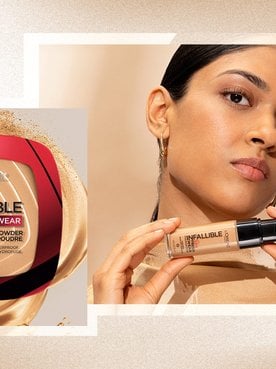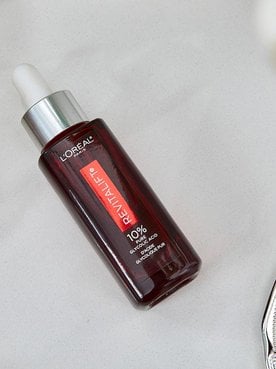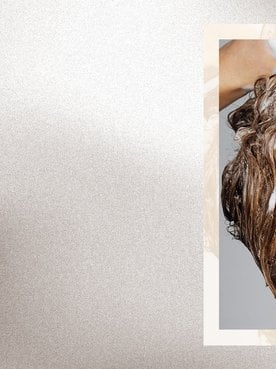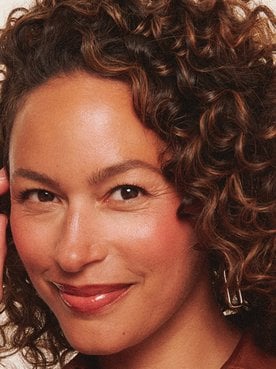A basic skincare routine should include a few key elements, including a facial cleanser, a moisturizer, and a sunscreen. However, the best routines also include a facial serum. These concentrated formulas can help target specific skin concerns, such as dryness, clogged pores, or dark spots. Finding the best face serum for your needs requires identifying your primary concerns and selecting a formula designed to help address them.
If you’re not sure how to choose a great face serum—or why you should use one in the first place—keep reading. Ahead, we’ll share everything you need to know about this skincare staple, including what they are, how to use them, and how to incorporate a skin serum into your routine.
Shop the Products

For dehydrated skin
Dryness and dehydration may seem similar, but they’re two separate concerns. Dryness occurs when the skin lacks oil, while dehydration occurs when the skin loses too much water. If you fall into the latter camp, consider adding the L’Oréal Paris RevitaLift Derm Intensives 1.5% Pure Hyaluronic Acid Serum to your routine. This lightweight, non-sticky formula delivers intense moisture, leaving the skin glowier and dewier-looking within a single use. Over time, it also helps plump the skin, visibly minimizing the appearance of fine lines and wrinkles.
For dull skin
As you age, your skin can start to lose its radiance. It’s completely normal—but if you want to reclaim some of that youthful glow, consider adding a brightening serum to your skincare routine. The L’Oréal Paris RevitaLift Derm Intensives 12% Pure Vitamin C + E + Salicylic Acid Serum, which contains 12% ascorbic acid (vitamin C), gets our vote. It instantly boosts radiance, while continued use over time helps improve the appearance of enlarged pores and fine lines, brightens the skin, and evens skin tone—an effortless way to get the best face serum for glowing skin results.

Shop the Products
For mature skin
Target uneven tone, texture, and other signs of aging with the L’Oréal Paris Age Perfect Serum Le Duo, a dual‑phase treatment that combines a nourishing translucent serum with a milky, pearly serum in one. It features collagen peptide to help skin feel smoother and look firmer, plus vitamins B3 (niacinamide) and C to support more even tone and renewed radiance. Dermatologist‑tested and suitable for sensitive skin, it layers comfortably morning and night, making it one of our best face serums for aging skin.

For dark spots and discolorations
Daily UV exposure, breakouts, and even the natural aging process can all contribute to dark spots and discolorations. Many serums are designed to help combat these concerns, in turn promoting a clearer, more even-looking complexion. If you’re facing down stubborn dark spots, we suggest reaching for the L’Oréal Paris Bright Reveal 12% Niacinamide + Amino Sulfonic + Ferulic Acid Dark Spot Serum. The dermatologist-validated formula provides gentle exfoliation to help brighten the skin and visibly fade the appearance of all types of dark spots, including post-acne marks, sun spots, and age spots. It’s suitable for all skin types and can be used twice daily to reveal a clearer, fresher-looking complexion over time.
For daily anti-aging
If you want one do-it-all anti-aging serum, try the L’Oréal Paris RevitaLift Triple Power Age-Defying Serum. This 3-in-1 formula is made to visibly reduce wrinkles, firm, and brighten aging skin. It combines a tri-peptide complex with vitamin C and hyaluronic acid to deliver immediate hydration and smoothing benefits. With continued use, it helps reduce wrinkles, re-firm the skin, even out the tone, and plump the skin's appearance. The milky, hydrating texture is non-greasy, fast-absorbing, and suitable for all skin types—including sensitive. Layer it seamlessly under moisturizer and SPF in the morning and under night cream in the evening.
For persistent lines and wrinkles
Facial serums play a crucial role in any effective anti-aging skincare routine. To combat the visible signs of aging, try adding the L’Oréal Paris RevitaLift Derm Intensives Night Serum, 0.3% Pure Retinol to your nighttime skincare routine. The potent formula helps address some of the most common visible signs of skin aging, including fine lines, wrinkles, dullness, and unevenness. And if you’re hesitant about using retinol for fear that it’ll dry your skin out, you’ll enjoy that this formula is designed to hydrate the skin to help counteract the potential drying effects of retinol. Still, if you’re a first-time retinol user, we recommend starting with one or two applications per week. As your skin acclimates, you can gradually work your way up to nightly usage.

Shop the Products
For gentle exfoliation
You may be used to exfoliating with face scrubs, but chemical exfoliants are becoming increasingly popular, and exfoliating facial serums are a great way to give them a try. Serums containing alpha-hydroxy acids (AHAs) and beta-hydroxy acids (BHAs), like lactic acid, glycolic acid, and malic acid, can be used to resurface skin for a smoother feel and more even appearance. If you’re looking for one to add to your lineup, we suggest the L’Oréal Paris RevitaLift Derm Intensives 10% Pure Glycolic Acid Serum. It immediately smooths and refines the skin, but you’ll reap the most benefits by using it consistently. After one week, you’ll enjoy a smoother, more youthful appearance, while two weeks of daily use leads to a visible reduction in dark spots and fine lines. Like the retinol serum, this formula is intended for evening use. Remember to follow it up with a gentle moisturizer and wear plenty of sunscreen during the day to protect your skin from damaging UV rays.
For skin barrier support
For healthy-looking (and healthy-feeling) skin, you need a strong skin barrier. Your skin barrier can help keep your skin moisturized, protect against environmental stressors, and more. If you’re looking for a serum that can help keep your skin barrier strong, we recommend giving the L’Oréal Paris Age Perfect Skin Care Cell Renewal Anti-Aging Midnight Serum a try. The luxe formula contains a patented antioxidant recovery complex and helps replenish the skin at night, when it’s most susceptible to repair. Smooth it onto clean skin before applying your go-to night cream, and you’ll enjoy softer, more radiant-looking skin come morning.
For the eye area
Your eye area deserves some love, too. The skin around your eyes is thin and uniquely vulnerable to age-related concerns, such as dryness, fine lines, and wrinkles (in fact, it’s where age-related skin changes tend to appear first). To give your eyes some extra care, reach for the L’Oréal Paris RevitaLift 2.5% Hyaluronic Acid + Caffeine Eye Serum. The lightweight, non-greasy formula provides immediate hydration and helps diminish the look of crow’s feet, dark circles, and under-eye bags. Use it alone, or layer it under a richer eye cream for an added boost of hydration.
Shop the Products
Can I Use Facial Serum Every Day?
In most cases, it’s not only okay to use your serum every day—it’s recommended to do so in order to reap the full benefits of the product. However, usage can vary depending on the type of serum, its ingredients, and the concentration. Your skin type can also play a role. If you have dry or sensitive skin, for example, it may be best to use a retinol or exfoliating serum every other day rather than daily. We suggest reading the instructions on the packaging for a clearer picture of when and how often to use your chosen serum. If you’re still unsure about the best approach for your skin, consult your derm next time you visit for a check-up.
Also, to get the most from your serums, be mindful of mixing and layering. Use one in the morning and one at night, or alternate days, and only layer when ingredients play well together. For example, use vitamin C in the morning and retinol at night to help minimize irritation. Hyaluronic acid and niacinamide are easy partners that pair well with most formulas. The best advice is to ask your dermatologist and start simple, building slowly.
Do I Need Both Serum and Moisturizer?
Yes, you should use both a facial serum and a moisturizer. That’s because they have different purposes. Serums, as we explained, target specific skin concerns, such as dullness or unevenness. Moisturizers, meanwhile, deliver deep hydration and help trap water in the skin. If you skip a serum and only use moisturizer, you may not see much improvement in your dark spots or dullness. If you use a facial serum without a moisturizer, your skin may begin to feel dry and tight. And remember, when layering products, always do so in order of consistency from thinnest to thickest to allow each formula to penetrate your skin effectively.
Common Skin Serum Mistakes To Avoid
While using skin serum is pretty straightforward, there are a few common mistakes you want to steer clear of when adding one to your routine. These include:
Not choosing a formula for your skin type or concerns
It seems pretty obvious, but when selecting a serum, you’ll always want to choose one that aligns with your skin type and concerns. What works well for your best friend or sister may not work as well for you (or vice versa). If you need help identifying which type of facial serum may best suit your needs, consult your dermatologist for guidance.
Layering incompatible ingredients
Some ingredient pairings can be too active on the same night. Retinol and alpha-hydroxy acids, for example, may increase sensitivity when layered. To prevent irritation, alternate them on different nights or split them into morning and evening routines.
Applying too much product
Since serums are so concentrated, you really only need a few drops to reap the benefits of your chosen formula. Applying too much could leave your skin slick or lead to product pilling. To avoid these concerns, only apply as much as instructed on the product packaging.
Skipping SPF
Finishing your morning skincare routine with broad-spectrum sunscreen is a must, especially if you’re using a serum with retinol or AHAs. These ingredients can make your skin more sensitive to the sun’s harmful rays and increase your risk of burns or sun damage.
Next Up: Everything You Need To Know About Adding a Face Serum To Your Routine
Photo courtesy of L’Oréal Paris.







